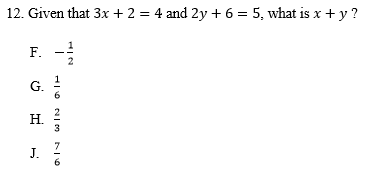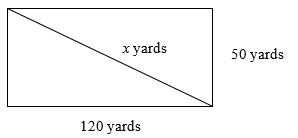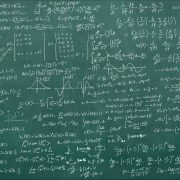Love it or hate it, there’s no escaping math. Students hoping to use the ACT® for admission to a dream college need to build the math chops for top ACT scores. ACT math questions are roughly ordered from easiest to hardest. Understanding this pattern can help you to pace yourself effectively: you’ll jump through the first questions faster in order to save time to tackle the tougher questions toward the end. Keep reading for our ACT math tips, so you can tackle every question, from easiest to hardest.
Tip 1: Know your geometry formulas for ACT math.
A decent chunk of the math section focuses on geometry, and unlike the SAT, the ACT doesn’t give you a handy little cheat sheet. ACT math success requires that you memorize these formulas:

Tip 2: Know what the question’s asking.
This seems pretty obvious, but the ACT math section can play tricks on you. For example:

The solution to this problem is x=2/3 and y=-1/2, and the test makers included both of these values as wrong answers to trick students who don’t read the entire problem. Always make sure you read the question carefully and know what you’re solving for before picking your answer.
Tip 3: Pay attention to units of measurement.
Another trick common to the ACT math section is sleight of hand with units. Many questions give measurements in more than one unit (a piece of lumber might be 8 feet long and 4 inches wide) or change units between the problem and the answer choices (if a truck drives 40 miles per hour, how many minutes will it take to travel 3 miles?).
You can avoid falling into this trap by converting all units into the units used in the answer choices before you begin solving the problem.
Tip 4: Visualize the problem.
If a question describes a scenario that lends itself to a diagram, draw one.
For example: Bayside High School’s practice field is 120 yards long and 50 yards wide. Mario runs sprints across the field diagonally from one corner to the opposite corner. How far does Mario run each sprint?

Visualizing the question will help you solve the problem. In this example, we know that we need to solve for x. We can also see the best way to solve the problem (1202 + 502 = x2).
This same advice applies when the test gives you a diagram but doesn’t label all of the information provided in the question—make sure you label everything!
Tip 5: Know when to fold ‘em.
The ACT math section includes some topics that only show up briefly in your high school math classes, like matrices and vectors. If you’re shooting for a perfect ACT math score, you’ll need to know every possible topic by heart—you can’t afford to miss any questions. But if your score goal is less than perfection, studying these rare topics isn’t going to give you much bang for your test prep buck. Instead, learn to recognize a topic you’re not familiar with and skip it. There’s no sense wasting previous time trying to remember a concept you learned years ago when you could be spending that time answering questions you’re more likely to get right. Instead, skip the unfamiliar concepts and go back to them if you have time remaining. And if you run out of time, don’t forget to guess—there’s no guessing penalty!
Get ACT Math Help
Want some extra ACT math help? Contact your local C2 Education center today and schedule a free consultation!









